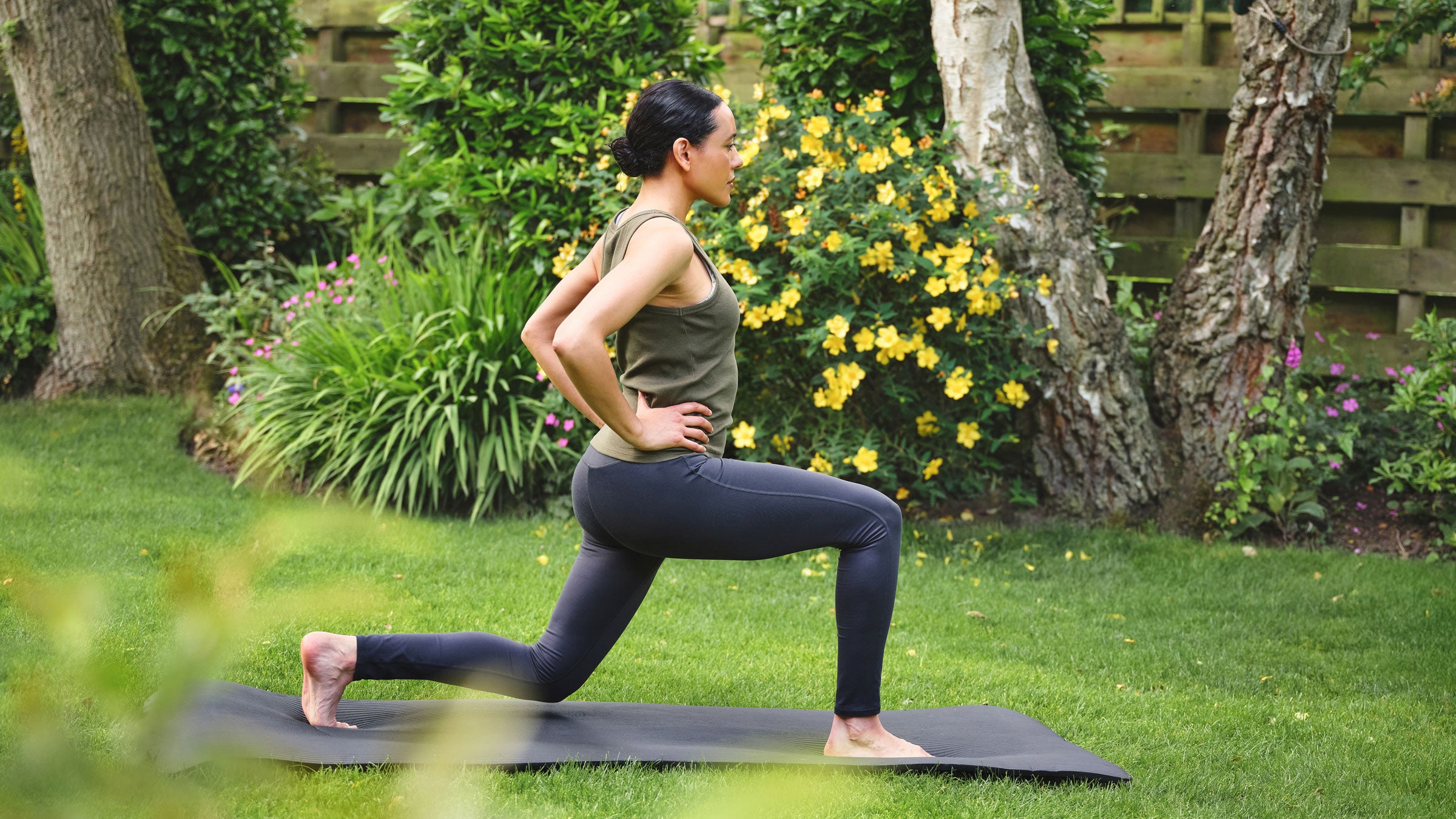Contrary to what you may think, you don’t need heavy weights to build leg strength. While a set of dumbbells can be a helpful tool while training, it’s also possible to strengthen your quads, calves, and hamstrings with bodyweight leg exercises.
The Benefits of Bodyweight Leg Exercises
1. You can avoid the gym.
I get it: When you’re a beginner, the gym can be an intimidating place. In your home, you have the ability to focus on just you and your workout—without feeling self-conscious or overwhelmed by your surroundings. Additionally, doing strength training exercises at home is more convenient.
Bodyweight leg exercises are also budget-friendly. Instead of shelling out money on dumbbells or other strength training tools, you can put that cash toward your next road race or ski trip.
2. You can still complete “leg day” while traveling.
When you’re away from home, it can be difficult to stick to your workout routine. Even if your hotel has a gym, it may lack the equipment you typically rely on. Bodyweight exercises help fill this gap. This type of workout can be done pretty much anywhere.
Whether you’re squeezing in some strength training between oceans dips or clocking your daily movement in your Airbnb, you only need your body to break a sweat.
3. You can master the basics.
If you’re a beginner or in the process of rebuilding your workout regimen after a break, bodyweight leg exercises can be a great way to build foundational strength before progressing to dumbbells. Instead of inadvertently injuring yourself by overloading your muscles with weights, you can dial in on the proper form and technique.
How to Complete This Workout
The number of sets and reps you should do of these bodyweight leg exercises will depend on your fitness level and training goals.
Building is more difficult when you’re just using your bodyweight, since you don’t have external resistance to overload your muscles. As a result, you’ll want to perform more reps than you would in a typical weighted set.
If you’re a beginner, you’ll likely see from bodyweight exercises. However, most studies suggest that experienced athletes may need to or complete more than 15 reps per set if they are using a reduced weight load to see strength gains.
In this workout, beginners should start with two sets of the following movements, . Advanced athletes should complete at least three sets with 15 or more reps per exercise.
11 Best Bodyweight Leg Exercises
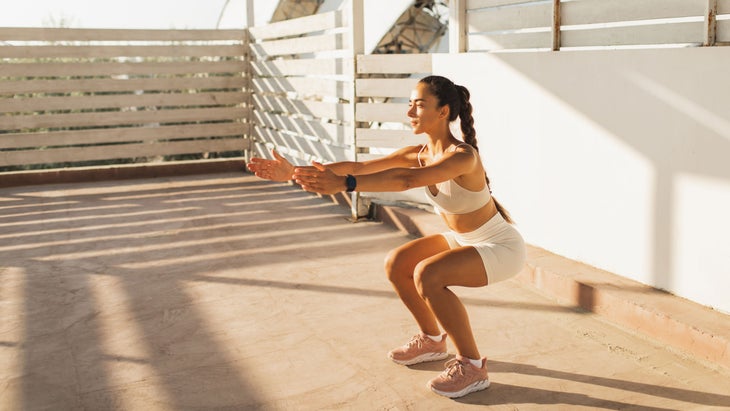
1. Bodyweight Squats
Bodyweight squats are a foundational compound leg exercise that strengthen all of the major muscles in your lower body. They’re also a helpful building block, teaching you a primary movement pattern used in more advanced lower body workouts.
How to do it:
- Stand upright with good posture. Keep your chest up, your core engaged, and your shoulders relaxed. Your feet should be slightly wider than hip-width apart.
- Bend your knees as you simultaneously lower your butt all the way back as if you’re going to sit in a chair. You can bring your arms forward in front of your body as a counterbalance. Make sure that your shins are parallel, and your knees do not extend beyond your toes.
- When your legs are at a 90-degree angle and your thighs are parallel to the ground, pause at the bottom of your squat.
- Press through your heels to stand up.
- Progress this exercise by pausing at the bottom of the squat position and holding each squat for 5 to 30 seconds, depending on your fitness level. This isometric hold will help build muscular endurance.
2. Jump Squats
Jump squats are a plyometric exercise to build power and explosive strength in your glutes, quads, and calves. In addition to being a great full-body exercise, this movement will give you a small cardio workout by elevating your heart rate.
- Follow the same steps for the bodyweight squat. Once you are at the bottom of your squat, thrust your arms upward toward the ceiling, and explode through the balls of your feet up into a vertical jump.
- Bend your knees and allow your arms to swing behind you as you descend to cushion your landing.
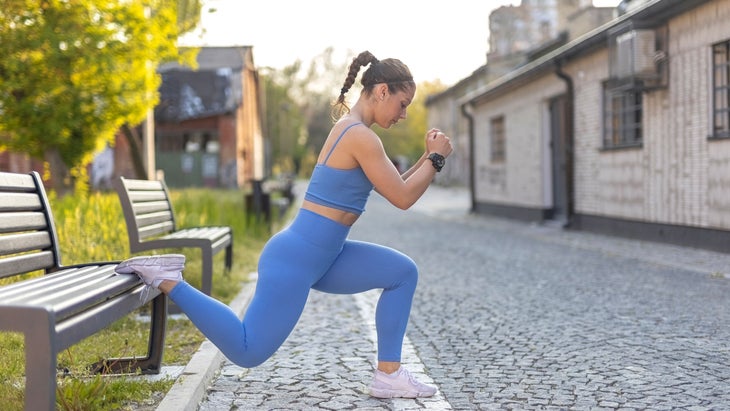
3. Rear-Elevated Split Squat/Bulgarian Split Squat
Commonly known as the Bulgarian split squat, this exercise is a great way to isolate the workload onto the quad and glute muscles in your front leg.
If you are doing this workout at home, you can use a coffee table, chair, or step to elevate your back foot. If you’re at a gym, use a weight bench.
How to do it:
- The set-up position for this exercise is important. Position the toes of your back foot on the bench behind you. Your front leg should be planted far enough forward to allow you to lunge without your knee extending beyond the toes of your front foot.
- Keep your core tight, your chest up, and your shoulders down. Drop into a lunge by bending your front knee until your thigh is parallel to the ground.
- Pause in this position before pressing through your front heel to return to the starting position.
- Complete all of the reps on one leg before switching to the other side.
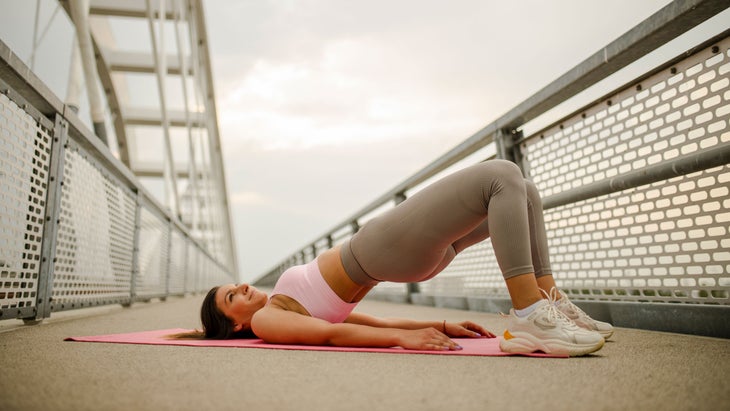
4. Glute Bridge
The glute bridge is a great beginner-friendly bodyweight exercise. Initially, start with both feet on the ground at the same time. As you build strength, progress to a single-leg bridge by lifting one leg up straight into the air and pressing through one heel at a time.
How to do it:
- Lie on your back with your knees bent and feet flat on the ground.
- Place your hands on the ground next to your body. To progress this movement, cross them over your chest.
- Squeeze your glutes. Lift your hips up until they create a straight line with your knees and shoulders.
- Pause and hold in this position, contracting your glutes for 2 to 3 seconds.
- Slowly lower back down.
5. Single-Leg Hip Thrust
While the glute bridge is a good beginner-friendly bodyweight leg exercise, more advanced athletes can progress to a single-leg hip thrust. Compared to the previous exercise, this isometric movement will create more of a challenge by loading all of your body weight onto one leg.
This exercise could be the key to building muscle. A 2019 study published in The Journal of Strength and Conditioning Research found that the hip thrust may be more effective than squats at strengthening your glutes.
How to do it:
- Rest your shoulder blades and upper back on the long edge of a weight bench, couch, chair, or coffee table. Bend your knees to approximately 90 degrees and keep your feet flat on the ground.
- For a single-leg hip thrust, lift one leg off the ground. Hold it in the air or rest it on the shin or thigh of the other leg. This is the starting position for this exercise.
- Drop your hips until your butt is right above the ground.
- Engage your glutes and hamstrings. Press through your grounded foot to lift your body back up into the starting position.
- Squeeze your glutes for 2 to 3 seconds before starting the next rep.
- Complete all of the reps on one leg before switching to the other side.
6. Heel Slides
Heel slides help build strength in your hamstrings, a critical muscle for climbing, running, and hiking. For this exercise, you’ll need to wear socks on a “slippery” surface, such as a tiled or hardwood floor. If you practice this movement at a gym, you can use sliding discs.
How to do it:
- Lie on your back with your heels on the floor.
- Lift your hips up into a glute bridge.
- Slowly straighten your knees as you slide your heels away from your butt. Maintain control. Make sure that your glutes stay lifted off of the ground.
- Keep tension in your hamstrings. Slide your feet back to the starting position. Your shins should be perpendicular to the floor.
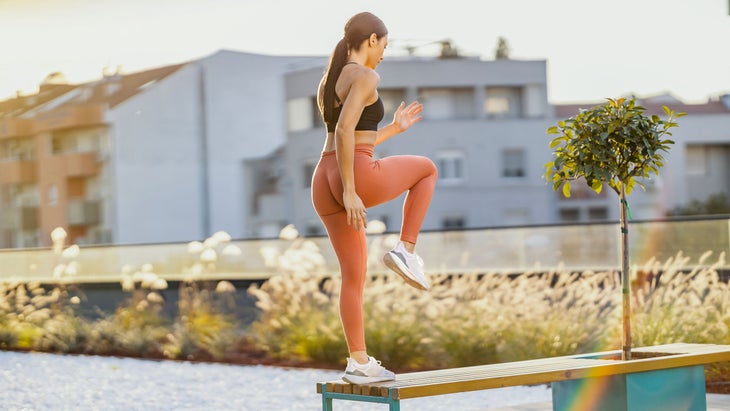
7. Step-Ups
This simple movement is more effective than you think. A 2020 study published in Journal of Sports Science & Medicine that step-ups are one of the best lower body strengthening exercises. At home, find a set of stairs or a sturdy chair to step onto. If you’re at the gym, use a plyometric box.
How to do it:
- Step up onto the box with one leg.
- Engage your lower body and core muscles. Push through the leading leg until you are firmly standing on the box.
- Step back down with the same leg that you led with.
- Complete all of your reps on one leg before switching to the other.
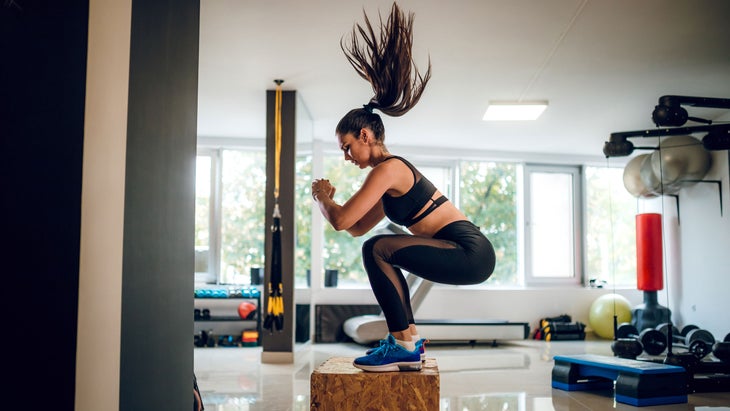
8. Box Jumps
If you’re an advanced athlete, you can progress from low-impact step-ups to explosive box jumps. Instead of stepping up onto your box one leg at a time, jump up with both legs.
How to do it:
- Use your arms to provide momentum. Draw them back and move into a half-squat with your legs.
- Explosively thrust your arms forward and jump up onto the box.
- As you land on the box, allow your arms to swing behind you to cushion your landing.
- Jump or step back down before starting the next rep.
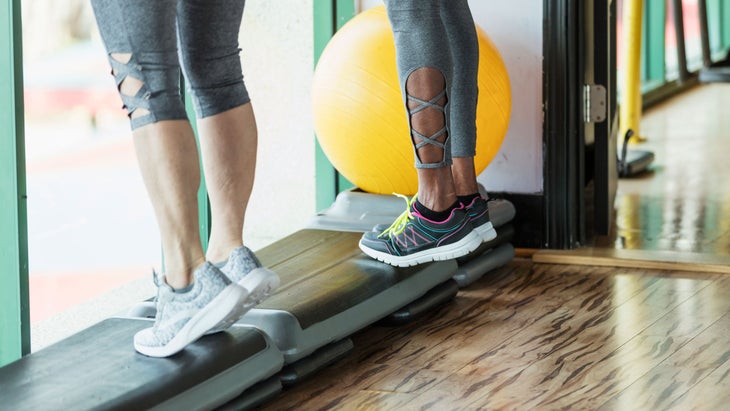
9. Calf Raises
Instead of practicing calf raises in place, do them off of a step. This subtle change will increase the range of motion in your heels. It will also elongate the eccentric portion of the exercise, which builds muscle mass and strength more efficiently than the concentric contraction of the movement.
How to do it:
- Stand on the edge of the step on the balls of your feet. Use your calf muscles to rise up onto your tiptoes.
- Pause at the top position for 2 to 3 seconds.
- Slowly lower down. Dip your heels below the level of the step.
- Pause again for 1 to 2 seconds.
- Press through the balls of your feet to lift back up onto your toes. Begin the next rep.
- Progress this movement by practicing it as a single-leg exercise, hooking one leg behind the calf of your other leg.
10. Curtsy Lunges
Curtsy lunges strengthen your gluteus medius and gluteus minimus, as well as the adductors in your inner thighs and your hip rotators. Like regular lunges, they also support your gluteus maximus, quads, hamstrings, and calves.
Balance and muscular engagement are key. Activate your abs and lower back muscles to find stability in this movement.
How to do it:
- Stand upright with good posture. Position your feet hip-width apart.
- Lift your right leg up. Cross it behind your left calf. Bend your left knee into a lunge. Push your arms forward for a counterbalance.
- Tap your right toe behind and to the outside of your left foot.
- Push through your left heel to stand up. Bring the right leg back to the starting position.
- Complete all of your reps on one leg before switching to the other.
11. Single-Leg Squats
Commonly known as pistol squats, single-leg squats are a great advanced bodyweight leg exercise. This movement builds strength by overloading your leg muscles on the weight-bearing leg, which triggers .
Because this is a unilateral exercise, it requires balance. Use your core and the muscles in your hips and ankles to find stability.
- Stand with feet slightly wider than shoulder-width apart. Keep your chest up and your core engaged.
- Lift your left leg and extend it in front of your body. Bend your right knee and sit your hips back.
- Squat as low as possible without losing your balance. If you’re a beginner, you may only be able to sink into a partial squat.
- Hold for a second. Press through your heel to stand back up.
- Complete all of your reps on one leg before switching to the other.


